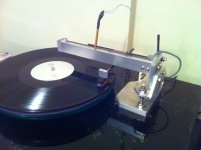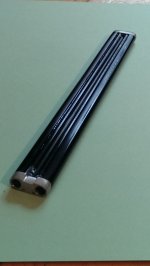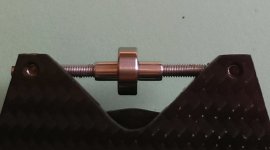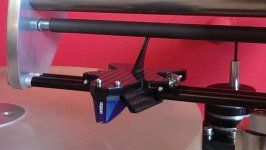Hi Colin ,
Looks clean , solid , gorgious !
I see you'r still happy with the AT120e cart I completed my collection with the AT130e today .
I completed my collection with the AT130e today .
i.e. 110 / 120 / 130 / 140 + the AT20Sla and a few real cheap AT's . recently also aquired some
ADC carts , XLM / VLM / 26 .. an old brick indeed .
THX
Paul
Looks clean , solid , gorgious !
I see you'r still happy with the AT120e cart
i.e. 110 / 120 / 130 / 140 + the AT20Sla and a few real cheap AT's . recently also aquired some
ADC carts , XLM / VLM / 26 .. an old brick indeed .
THX
Paul
Last edited:
Hi all.
I've finished making all the components for my two rod mod.
At the moment it's set up with the ball races and solid axles. It's just played through its first side with no obvious problems with cartridge set to manufacturers recommended tracking force. I'll experiment with this setup for a couple of days then try the pin bearings. Of course all findings, good and bad, will be shared.
In my excitement to get the deck set up I forgot to take all the photos I ment to. I'll take some more for my next post.
Hi Colin.
Nice work. The whole arm has a really cohesive look. I love the way square headshell ties it all together.
Niffy
I've finished making all the components for my two rod mod.
At the moment it's set up with the ball races and solid axles. It's just played through its first side with no obvious problems with cartridge set to manufacturers recommended tracking force. I'll experiment with this setup for a couple of days then try the pin bearings. Of course all findings, good and bad, will be shared.
In my excitement to get the deck set up I forgot to take all the photos I ment to. I'll take some more for my next post.
Hi Colin.
Nice work. The whole arm has a really cohesive look. I love the way square headshell ties it all together.
Niffy
you ALL are pissin' me off...
... 'cause you make such beautiful things. Wish I had the facilities, materials and skills to make something with the fit and finnish like on vynuhl-addict's and spinning wheels' examples of this arm. They are stunning to look at and I hope they stunningly good to listen to as well.
I think these arms are just a tiny bit more 'sphisticated than the 219. I'll stick to dumb simple, cause that's what I do best. I'd love to hear a showdown between a 219 and either of these tonearms, just for my own edification. Who knows, maybe I'll become a proponent of these arms...
... not that I have anything against any other designs. I like the simplicity of the 219 but will be the first to suggest that it is but one way to skin a cat and wish nothing but luck to anyone trying their hand at this hobby. I just suck at construction compared to vynuhl-addict and spinning wheel.
... 'cause you make such beautiful things. Wish I had the facilities, materials and skills to make something with the fit and finnish like on vynuhl-addict's and spinning wheels' examples of this arm. They are stunning to look at and I hope they stunningly good to listen to as well.
I think these arms are just a tiny bit more 'sphisticated than the 219. I'll stick to dumb simple, cause that's what I do best. I'd love to hear a showdown between a 219 and either of these tonearms, just for my own edification. Who knows, maybe I'll become a proponent of these arms...
... not that I have anything against any other designs. I like the simplicity of the 219 but will be the first to suggest that it is but one way to skin a cat and wish nothing but luck to anyone trying their hand at this hobby. I just suck at construction compared to vynuhl-addict and spinning wheel.
... 'cause you make such beautiful things. Wish I had the facilities, materials and skills to make something with the fit and finnish like on vynuhl-addict's and spinning wheels' examples of this arm. They are stunning to look at and I hope they stunningly good to listen to as well.
I think these arms are just a tiny bit more 'sphisticated than the 219. I'll stick to dumb simple, cause that's what I do best. I'd love to hear a showdown between a 219 and either of these tonearms, just for my own edification. Who knows, maybe I'll become a proponent of these arms...
... not that I have anything against any other designs. I like the simplicity of the 219 but will be the first to suggest that it is but one way to skin a cat and wish nothing but luck to anyone trying their hand at this hobby. I just suck at construction compared to vynuhl-addict and spinning wheel.
Yeah, but who wants a skinless cat?
BGruhn MeOwwwww!
Wow... that linear arm is quite the construction.
In a word ? Does that equal / approach Nanooks' simple arm?
Never used Nanooks arm but I have a Micro Seiki M505 II and a Michell Technoarm. My single tube version beats them both by a large margin. Surface noise is minimal and the music sounds natural and just right. Currently running a AT F5 MC cart with very few skips.
Just been too busy with other things to try the double tube version. I did have some problems with bearings but I seem to have been the exception. I have used mainly off the shelf parts in a minimilistic way and it works fine.
Regards,
Kffern
without trying to hijack this thread...
... for those that have built and used the 219 the comments generally go something like this:
And they have been compared to way more expensive arms...(upto about USD$3k or so) favourably.
check out the nanook 219 thread if interested.
Again, I am not trying to take anything away from this build or any attempts at a tonearm. I just think I stumbled upon Charles Altmann's design and spent some time developing and refining it a bit.
... for those that have built and used the 219 the comments generally go something like this:
- "putting the rega/grado on at the same time as the arrow/kenwood n39, the arrow is the better by a big margin"
- "I am continually amazed by how good the 219 sounds - crystal clear, good bass - a steal of a deal"
- "One very good combination with the 219 is an old Sonus Blue Gold "
- "The P8ES SuperNova didn't like the arm. Lot of resonances so it likes a heavier arm."
- "It revived my whole stock of albums... Shouldn't sound this good."
And they have been compared to way more expensive arms...(upto about USD$3k or so) favourably.
check out the nanook 219 thread if interested.
Again, I am not trying to take anything away from this build or any attempts at a tonearm. I just think I stumbled upon Charles Altmann's design and spent some time developing and refining it a bit.
Thank you all for the comments, I thought I'd put some time into a more final version and built more solid  . It's a much stiffer build than the prior version, and surprisingly has taken the sound another notch up along with a lower noise floor. The dynamic punch is better, and a tad more resolved. The carriage and track is unchanged.
. It's a much stiffer build than the prior version, and surprisingly has taken the sound another notch up along with a lower noise floor. The dynamic punch is better, and a tad more resolved. The carriage and track is unchanged.
Stew,
Your more than welcome to post here, its all apples and oranges, pivoted versus linear and each have their strengths .
.
Colin
Stew,
Your more than welcome to post here, its all apples and oranges, pivoted versus linear and each have their strengths
Colin
thanks for the welcome Colin...
...I just don't want to create a "me vs. the world" situation regarding tonearm design. Just as I feel that there are good examples of idler, rim, DD and belt drive turntables there are good examples of pivoting vs.non-pivoting tonearms. Even the uni-pivot vs. multi-pivot bearing types in a pivoting types. And as long as all know that my intention is not to create controversy for it's own sake. I don't spend my time on the forum "trolling" for arguments.
Bare: Thanks for the mention here. Have you built a 219? If so please post your results in the my latest iteration of "Nanook's 219 tonearm"..thread.
Whether a pivoting "zero tracker",linear or pivoting type, makes no difference to me. I trust my ears enough to figure that out on my own. Other than the tonearm on my Garrard Zero100SB turntable (I'll call that a "zero tracker"), I have no direct experience with any linear arms (except 20 years ago or so. A friend had a ET II arm that worked great and had a good sound with a Koestu Black Goldline cartridge).
bgruhn: I agree.
Colin:your arm looks great and as far as fit and finish goes, isn't it good. What details need to be cleaned up?
Tonight I'm rotating silver, cause I'm trying to warm up some tubes (300B's) that haven't been used for quite a while.
I am hoping to get an Opus3 Cantus in the next little bit so that I can have something other than my SME309 and 219 to compare to. Only thing is that if I take a stab at DIY linear tracker, I'm afraid it will end up being FUGLY and sound great and I won't want to mess with it!
...I just don't want to create a "me vs. the world" situation regarding tonearm design. Just as I feel that there are good examples of idler, rim, DD and belt drive turntables there are good examples of pivoting vs.non-pivoting tonearms. Even the uni-pivot vs. multi-pivot bearing types in a pivoting types. And as long as all know that my intention is not to create controversy for it's own sake. I don't spend my time on the forum "trolling" for arguments.
Bare: Thanks for the mention here. Have you built a 219? If so please post your results in the my latest iteration of "Nanook's 219 tonearm"..thread.
Whether a pivoting "zero tracker",linear or pivoting type, makes no difference to me. I trust my ears enough to figure that out on my own. Other than the tonearm on my Garrard Zero100SB turntable (I'll call that a "zero tracker"), I have no direct experience with any linear arms (except 20 years ago or so. A friend had a ET II arm that worked great and had a good sound with a Koestu Black Goldline cartridge).
bgruhn: I agree.
Colin:your arm looks great and as far as fit and finish goes, isn't it good. What details need to be cleaned up?
Tonight I'm rotating silver, cause I'm trying to warm up some tubes (300B's) that haven't been used for quite a while.
I am hoping to get an Opus3 Cantus in the next little bit so that I can have something other than my SME309 and 219 to compare to. Only thing is that if I take a stab at DIY linear tracker, I'm afraid it will end up being FUGLY and sound great and I won't want to mess with it!
Stew,
When this arm began at the start of the thread the sound was so far ahead of my modified Rega rb250 it was nearly laughable . As it has prgressed it has become more refined, there is an immediacy to a linear tracker that's palpable in a highly musical degree. Weaknesses?, hard to find, it's so good at this point only weaknesses are discovered through trial of different materials and builds I'm finding. Not to imply its a super arm, to me it is of course, but one can only measure it by their personal musical enjoyment
. As it has prgressed it has become more refined, there is an immediacy to a linear tracker that's palpable in a highly musical degree. Weaknesses?, hard to find, it's so good at this point only weaknesses are discovered through trial of different materials and builds I'm finding. Not to imply its a super arm, to me it is of course, but one can only measure it by their personal musical enjoyment  .
.
Colin
When this arm began at the start of the thread the sound was so far ahead of my modified Rega rb250 it was nearly laughable
Colin
Pin Bearing v Ball Race pt1
Hi all.
This is my first part of describing my two rod mod.
The first pic shows the new rail before it was fitted to the arm. The rail consists of two 4mm borosilicate glass rods. The rods are supported in an acrylic block which has a 9.5mm groove routed in its top. The glass rods sit within this groove separated by a 1.5mm wide carbon fibre baton. The aluminium blocks at the ends allow for solid mounting.
The second pic shows the bearing (3x10x4mm ceramic hybrid) mounted on its solid axle. The picture was taken before the carriage was fitted to the arm and aligned.
The third pic shows the arm as it is set up now.
I initially set the tracking force to the manufacturers recommended value.(1.8g). I repeated the pencil tap test as I had with previous rail as described on page 164. With the previous rail the tap test was inaudible through the speakers at normal listening levels and was only heard as a very rapid low thud with the volume set to what would be an antisocial level with music. The test was preformed whist switching the amplifier between sources so I could tell what was added over the directly heard impact. The new rail did not fair so well with the taps being just audible at normal levels. The note through the speakers was higher pitched and harsher.
Rolling the carriage along the rail also resulted in higher level of directly heard sound due to rail/bearing contact than with the previous rail.
Next I played the same record repeatedly gradually decreasing tracking force. At 1g the arm tracked flawlessly, at 0.9g the first hint of tracking distortion was heard but the stylus remained in the groove. This was tested using a sacrificial record with about 2mm of wobble. So answering my own question of a couple of weeks ago: the maximum carriage mass for use with a high compliance cartridge. Definitely over the 50g mass of my carriage.
Enough of the boring stuff.
How did the sound compare to the pin bearings with the old rail and large acrylic wheels?
The difference in sound quality was not massive but was immediately noticeable. Starting at the bottom. Bass weight is the same but there is a definite improvement in articulation. There's just that little bit more detail at the bottom end.
The entire midrange has a "sweeter" tone. Voices, both male and female, sound a bit more real.
The sound stage and imaging were areas that I had anticipated improvements in. With the old rail I reckon, due to the eccentricity of the old wheels, that the cantilever spent most of its time at least 1degree off tangential. I was not disappointed. I now have a much larger sound stage with each sound being more focused in location.
All is not so peachy at the top end. The sweetness heard in the mid range extends through the top. With this there seems to be a slight and I mean slight loss of high end detail.
Conclusions.
Overall the sound is better. If I can keep the improvements to bass and mid and regain that tiny loss in the top I'll be very happy.
A friend has just popped around I'll finish up in a while.
Niffy.
Hi all.
This is my first part of describing my two rod mod.
The first pic shows the new rail before it was fitted to the arm. The rail consists of two 4mm borosilicate glass rods. The rods are supported in an acrylic block which has a 9.5mm groove routed in its top. The glass rods sit within this groove separated by a 1.5mm wide carbon fibre baton. The aluminium blocks at the ends allow for solid mounting.
The second pic shows the bearing (3x10x4mm ceramic hybrid) mounted on its solid axle. The picture was taken before the carriage was fitted to the arm and aligned.
The third pic shows the arm as it is set up now.
I initially set the tracking force to the manufacturers recommended value.(1.8g). I repeated the pencil tap test as I had with previous rail as described on page 164. With the previous rail the tap test was inaudible through the speakers at normal listening levels and was only heard as a very rapid low thud with the volume set to what would be an antisocial level with music. The test was preformed whist switching the amplifier between sources so I could tell what was added over the directly heard impact. The new rail did not fair so well with the taps being just audible at normal levels. The note through the speakers was higher pitched and harsher.
Rolling the carriage along the rail also resulted in higher level of directly heard sound due to rail/bearing contact than with the previous rail.
Next I played the same record repeatedly gradually decreasing tracking force. At 1g the arm tracked flawlessly, at 0.9g the first hint of tracking distortion was heard but the stylus remained in the groove. This was tested using a sacrificial record with about 2mm of wobble. So answering my own question of a couple of weeks ago: the maximum carriage mass for use with a high compliance cartridge. Definitely over the 50g mass of my carriage.
Enough of the boring stuff.
How did the sound compare to the pin bearings with the old rail and large acrylic wheels?
The difference in sound quality was not massive but was immediately noticeable. Starting at the bottom. Bass weight is the same but there is a definite improvement in articulation. There's just that little bit more detail at the bottom end.
The entire midrange has a "sweeter" tone. Voices, both male and female, sound a bit more real.
The sound stage and imaging were areas that I had anticipated improvements in. With the old rail I reckon, due to the eccentricity of the old wheels, that the cantilever spent most of its time at least 1degree off tangential. I was not disappointed. I now have a much larger sound stage with each sound being more focused in location.
All is not so peachy at the top end. The sweetness heard in the mid range extends through the top. With this there seems to be a slight and I mean slight loss of high end detail.
Conclusions.
Overall the sound is better. If I can keep the improvements to bass and mid and regain that tiny loss in the top I'll be very happy.
A friend has just popped around I'll finish up in a while.
Niffy.
cont...
Hi all, I'm back.
Does the overall improvement mean that the ball races are better? That's a difficult one. Remember the old wheels were slightly eccentric causing the cantilever to be constantly pushed from tangential. All of the improvements heard could be attributed to the ball races being concentric. If I manage to cure this problem with the old wheels will I see the same or greater improvement? I don't know. Could the very slight loss in top end detail be due to the new rail being less dead than the old and could a more solid two rod rail work better? Is the sweeter midrange due to coloration and if so is this coloration caused by the same thing that affected the treble? I think the midrange is more neutral but without a master-tape to compare it to its difficult to say. The treble detail loss may also be due to very slight bearing chatter.(oops I mentioned that C word).
I definitely have some more experimenting to do.
One thing that doesn't seem to have caused a problem is the raising of the pivot point. With the old rail the pivot was 8.5mm above the record surface. Due to the way the two rod system works the pivot point has been raised to 16.1mm. I've heard not a hint of wow but then my record clamping system is very effective at eliminating warps. The raising has moved the pivot from below the centre of mass to just above it. This may have had a positive effect.
The next change will be to try the pin bearings with the oversized hubs effectively using the ball races as wheels. I have a good feeling about this change.
Niffy
Hi all, I'm back.
Does the overall improvement mean that the ball races are better? That's a difficult one. Remember the old wheels were slightly eccentric causing the cantilever to be constantly pushed from tangential. All of the improvements heard could be attributed to the ball races being concentric. If I manage to cure this problem with the old wheels will I see the same or greater improvement? I don't know. Could the very slight loss in top end detail be due to the new rail being less dead than the old and could a more solid two rod rail work better? Is the sweeter midrange due to coloration and if so is this coloration caused by the same thing that affected the treble? I think the midrange is more neutral but without a master-tape to compare it to its difficult to say. The treble detail loss may also be due to very slight bearing chatter.(oops I mentioned that C word).
I definitely have some more experimenting to do.
One thing that doesn't seem to have caused a problem is the raising of the pivot point. With the old rail the pivot was 8.5mm above the record surface. Due to the way the two rod system works the pivot point has been raised to 16.1mm. I've heard not a hint of wow but then my record clamping system is very effective at eliminating warps. The raising has moved the pivot from below the centre of mass to just above it. This may have had a positive effect.
The next change will be to try the pin bearings with the oversized hubs effectively using the ball races as wheels. I have a good feeling about this change.
Niffy
Very nice, Niffy!
Can we see the back end, the counterweight area?
Hi Directdriver.
Of coarse you can.
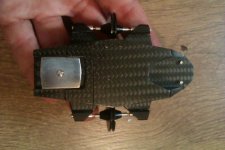
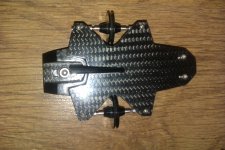
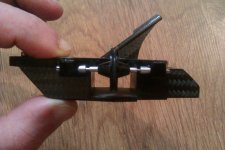
I'm sorry these pictures aren't too good. I put the phone with better pictures in the washing machine...Oops. These are quite old and I don't have a clear enough image from directly behind. The counter weight is made from 3mm stainless and sits in a recess under the rear of the arm. During use the bottom of the weight is only 4mm above the record surface. That's as low as I could possibly make it without the weight hitting the record when queueing. The third pic shows the carriage from the side. The rear section had to be stepped up to keep the 2.5mm clearance when queueing. Adjustment is made by loostening the caphead screw from above them manually sliding it and the weight. Its a bit of a fiddle but I thought thats better than a complex screw adjuster. This system solidly locks the weight into the bottom of the carriage effectivly making it all one component. The whole rear end is supported by a large buttress that connect the top and bottom parts of the arm. As the carriage was designed specifically with the ortofon 2M black in mind (I'm using the blue for evaluation) a wide force range is not nessary. The total adjustment range is only about 0.7g
Niffy
Niffy,
Very nice carriage, its almost the vinyl playback equivalent of the batmobile . I'm currently overjoyed with the last build, wrapped up in listening to many records currently. On the bearing aspect, you will notice a sliding noise with radial bearings, only when slid by hand but non existent during vinyl play, even on the runout groove.
. I'm currently overjoyed with the last build, wrapped up in listening to many records currently. On the bearing aspect, you will notice a sliding noise with radial bearings, only when slid by hand but non existent during vinyl play, even on the runout groove.
Colin
Very nice carriage, its almost the vinyl playback equivalent of the batmobile
Colin
Niffy,
Just read your last comment, missed that one. We each have our own views on the bearing aspect, but from my finds the best sound comes from the center of mass/ gravity being below the pivot point, its also much more stable and rigid this way. I have not had any issue with the highs, but we are using radically different carriages for playback.
Colin
Just read your last comment, missed that one. We each have our own views on the bearing aspect, but from my finds the best sound comes from the center of mass/ gravity being below the pivot point, its also much more stable and rigid this way. I have not had any issue with the highs, but we are using radically different carriages for playback.
Colin
Niffy,
Just read your last comment, missed that one. We each have our own views on the bearing aspect, but from my finds the best sound comes from the center of mass/ gravity being below the pivot point, its also much more stable and rigid this way. I have not had any issue with the highs, but we are using radically different carriages for playback.
Colin
Hi Colin.
I think I've come to the same conclusion regarding the location of the centre of mass. I think having the com below the pivot adds a bit of stability to the sound but as I've made so many changes it's difficult to say which change has affected which aspect of the sound. I wouldn't say I'm having issues with the treble. The treble detail is excellent, it was just a tiny bit more excellent with the previous setup. I think the tonal quality of the top end has actually improved, as it appears to have done throughout the entire audible range.
I'll live with the arm as it is for a couple more days to thoroughly familiarize myself with its sound then it's pin bearing time again.
Niffy
- Home
- Source & Line
- Analogue Source
- DIY linear tonearm
